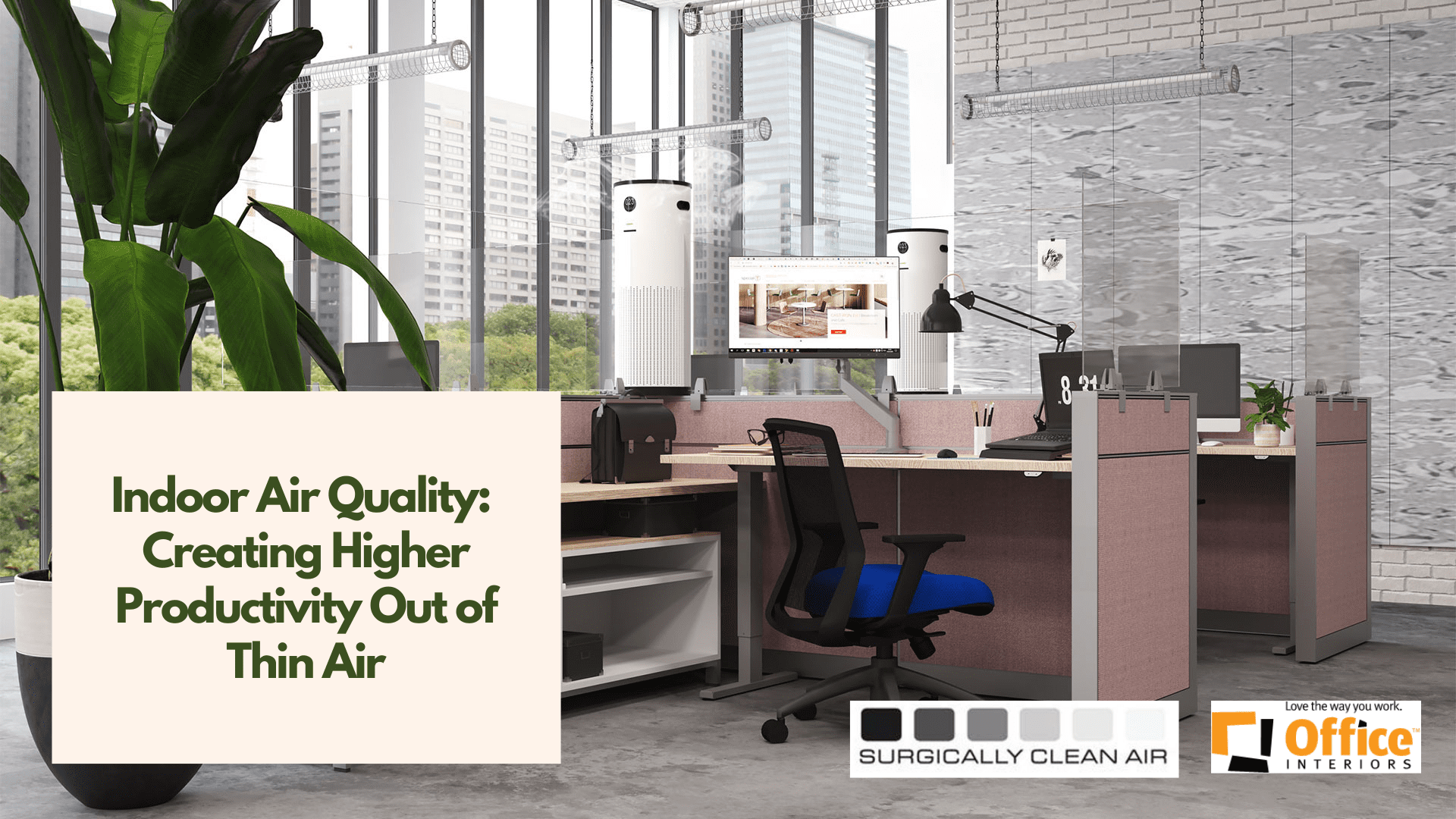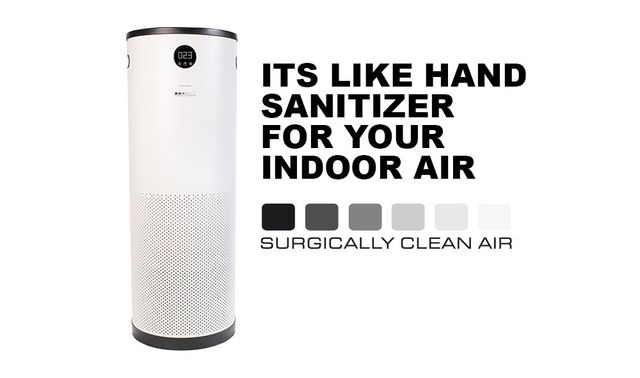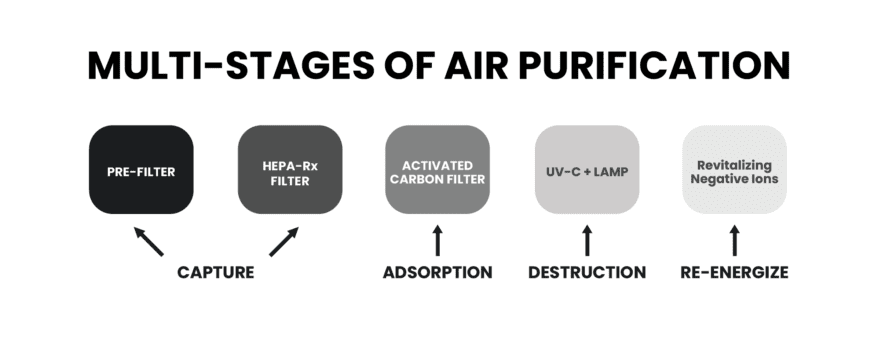How often do you consider the indoor air quality in your office and how it affects the well-being and productivity of your team? Chances are it’s not often.
While some of us may take note of the air quality in our homes, we rarely give much thought to the effects of air quality in an office. There is a tendency to assume that, as long as commonly used standards for air quality are met, it won’t be an issue.
Every human being breathes about 11,000 litres of air every day and, if you work in an office, the air in your workplace accounts for at least one-third of your daily intake. Considering these statistics, the quality of the air we breathe at work can have a big impact on our health, comfort, and overall productivity. While most companies have accepted the shift towards a healthier work environment through wellness programs or on-site fitness centers, air quality is a factor that is easily overlooked.
At Office Interiors, we understand that to perform at your best, your workspace needs to be comfortable and safe. We are always looking for new ways to enhance our value to our customers by providing solutions that contribute to a healthier, happier and more productive workday. That is why we couldn’t be happier to be partnering up with Surgically Clean Air to provide air purifying products so you and your team can breathe easy and continue to love the way you work!
In light of this new addition to our offerings, we wanted to dig deeper into the discussion of indoor air quality (IAQ) and how our partners at Surgically Clean Air have designed their purification devices to benefit office spaces today.
Let’s start at the beginning.
What Really Causes Air Quality Problems at the Office?
When it comes to indoor air pollution, there are often several factors that can go unnoticed. Unlike outdoor pollution that can be easily sensed (e.g., dark smoke, unpleasant smells), indoor pollution hides behind comforting breezes from air conditioners, and pleasant scents from air fresheners. Since it’s invisible to the naked eye, it can be easy to dismiss its existence.
Here are some common contributors to poor office or indoor air quality:
- Naturally Occurring Pollutants– Mold, dust, bacteria, pollen, and animal dander are just some of the many naturally-occurring pollutants in indoor spaces. These types of contaminants can affect both old and new indoor areas and can be particularly harmful to those who suffer from asthma or other allergies.
- Chemical Pollutants– Another group of pollutants that negatively affect the air we breathe are chemical pollutants, such as tobacco smoke, gases like carbon monoxide and nitrogen dioxide, and waste products from everyday things we use (e.g., paint, cleaning supplies). Virtually every commercially manufactured item can also emit harmful chemical pollutants. This list is a long one, but some more common ones include polyurethane, formaldehyde, and VOCs.
- Small Particles and Other Waste Products– Contaminants from outdoors can also easily make their way inside, which can have large effects on your health. Particles from dust, dirt, smoke, and materials from construction are just some common pollutants that impact air quality in the office and promote indoor air pollution.
How Does Air Quality Impact Productivity?
According to the Environmental Protection Agency (EPA), indoor air can be up to five times more polluted than the smoggy atmosphere outside. The presence of harmful particles in the air may make employees more susceptible to eye and nose irritation, cold, flu, dizziness, and headache. Prolonged exposure to polluted indoor air may lead to severe conditions such as chronic bronchitis, heart disease, and lung cancer. This can increase the number of sick leaves, resulting in a productivity slowdown.
The number of negative ions present in the air also influences our mood. The air at the beach, beside a waterfall, and in the mountains is said to contain tens of thousands of negative ions. In contrast, there are very low levels of negative ions at work and at home due to the lack of fresh air rotation and the staleness of the air– even air conditioning depletes indoor air of negative ions. This lack of negative ions can be another reason for people to experience fatigue, mood swings, depression, and loss of concentration, resulting in an unhappy working environment and lower productivity.
Still not convinced of the impact air quality can have on workplace productivity? Then consider this recent study.
Researchers studied Californian workers whose salary was based on the weight of fruit they picked each day. Comparing daily salaries to daily air quality measures, the researchers found that the workers earned the least amount of money on days with the highest ground-level ozone readings. In other words, the worse air quality got, the less productive workers were.
The overall drop in efficiency? From three to five percent, on average.
How Can Surgically Clean Air Purifiers Benefit Your Office Space?
We’re glad you asked! Let’s break down the 4 pillars of air purification that the devices are built upon.
- Robust technology – Made with premium steel construction, visual sensors for real-time air quality monitoring and 6 distinct stages of filtration that capture 99.998%* of airborne particles down to 0.1 microns for healthy air quality.
- Whisper quiet – Equipped with noise-cancellation capabilities through a sound dampening design that enables the devices to operate at a range of 35dB – 55dB. It’s quieter than most household dishwashers and helps keep your team on task without any auditory distractions.
- Moves a lot of air – Easily cleans and purifies large spaces with multiple air changes per hour.
- Low Operating Cost – If you combine robust technologies and the capability to move a large volume of air, these systems have the lowest cost per cubic foot of air cleaned over a 5-year period.
Click on the button below for an interactive experience to better understand how the JADETM 2.0 works.
Now, let us walk you through the step-by-step process of how the purification devices work.
- The pre-filter stage catches the largest particles as room air is drawn through the intake chamber. The anti-biotic pre-filter prevents most bacteria and germs from growing.
- The dual-stage electronic precipitator stage captures particulate down to 0.01 microns in size, 15,000 times smaller than a human hair. In the ionizing section of the precipitator, billions of microscopic particles become electronically charged as they pass through the powerful electrical field. The collector plates in the precipitator immediately attract and contain these ‘charged’ particles.
- The activated carbon filter and molecular sieve stage absorb odours, chemicals and gases.
- The photo-catalytic stage captures residue from destroyed organic VOCs, bacterial and viral organisms.
- The dual high-intensity, U.V. (ultraviolet) chamber not only disables the DNA of viruses and bacteria but also utterly destroys them.
- Before the pure, clean air is circulated back into the room, the air is revitalized with negative ions. Negative ions increase the flow of oxygen to the brain; resulting in higher alertness, decreased drowsiness and more mental energy.
Say Goodbye to Poor Air Quality
If you’ve made it to the end of this article, by now you know that indoor air quality is a top priority in the workplace. The addition of an air purification device could help you boost the well-being and performance of your team and serve as a refreshing new benefit to your wellness program.
We feel that this new partnership with Surgically Clean Air represents our unwavering commitment to helping our customers maintain a productive and safe office environment. If this article has sparked your interest in indoor air quality and you want to look into an air filtration solution at your office, feel free to reach out to us any time!
Ahona Saha
Marketing Assistant
Office Interiors






